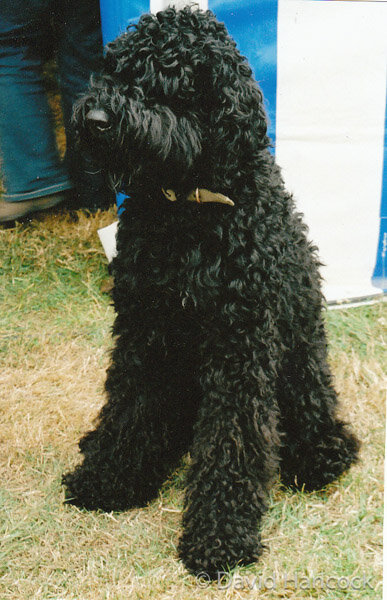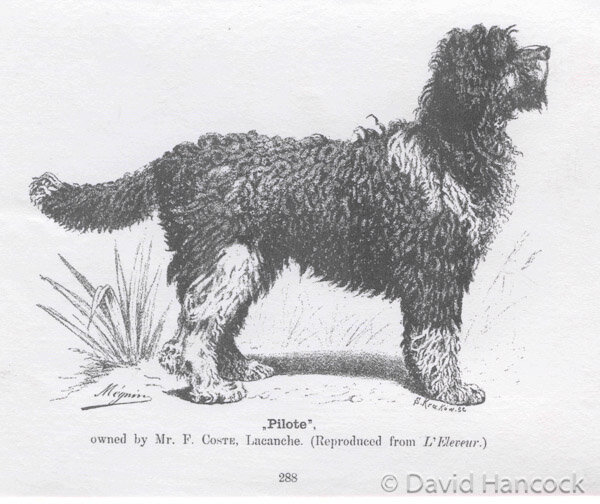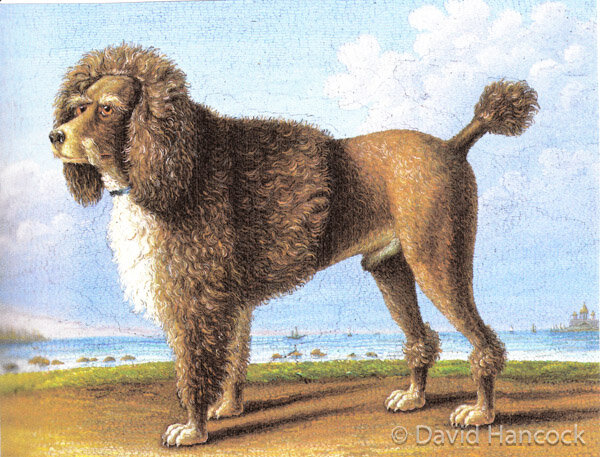1111
A NEW INTEREST IN BARBETS
By David Hancock
The Times of London devoted half a page on the 11th of January 2018 to the (to them) dramatic news of the recognition by the Kennel Club in London of their 220th pedigree breed of dog. It could have been on the same date a century earlier, or, if the KC had been formed then, a century before that. What the leading British national daily paper failed to mention was that the Barbet is the French Water Dog - the KC has never shown any interest in the British Water Dog, well known in East Anglia and on the Tweed from medieval times and prized by both the fishing community and the wildfowlers there. The advent of firearms led to many changes in the use of dogs in the hunting of feathered game. No longer were the dogs just required to bring back the valuable arrows or bolts but expected to retrieve shot game on land as well as from water. The finding of shot game on land, especially as the range of munitions increased, demanded top quality scenting powers, the persistence of a hound and the biddable qualities of a sheepdog. Waterdogs were certainly talented!
In due course, the breeds of land spaniel developed alongside the water spaniels, which usually had a high proportion of water-dog blood, as their coat texture revealed. The Barbet in France was one of the prototypal water dogs and after nearly becoming extinct in the 19th century, yet probably predating the Poodle, was once clever enough and versatile enough to be favoured by French poachers and continental travelling families. They were used by French fishing communities and may have contributed blood to the Newfoundland on the North-eastern American seaboard. Certainly, some of the early Newfoundlands had a distinct Barbet look to them. They are strapping dogs, powerful swimmers and clever dogs with great energy. It would be good to see them being used by wildfowlers, they are well-equipped to be really good water retrievers.
Gervase Markham advised, early in the seventeenth century, on the subject of training a 'Water Dogge' to retrieve, writing: "Traine him to fetch whatsoever you shall throw from you...anything whatsoever that is portable; then you shall use him to fetch round cogell stones, and flints, which are troublesome in a Dogges mouth, and lastly Iron, Steele, Money, and all kindes of metall, which being colde in his teeth, slippery and ill to take up, a Dogge will be loth to fetch, but you must not desist or let him taste food till he will as familiarly bring and carry them as anything else whatsoever." The much quoted Dr. Caius identified the curly-coated Water Dogge as "bringing our Boultes and Arrowes out of the Water, which otherwise we could hardly recover, and often they restore to us our Shaftes which we thought never to see, touch or handle again." Such water-dogs were utilised on the continent too; in The Sketch Book of Jean de Tournes, published in France in 1556, we see illustrated 'The Great Water Dogge', a big black shaggy-headed dog swimming out to retrieve a duck from a lake. This sketch could so easily have been of the contemporary Barbet, still available in France (and now here), acknowledged as an ancient type, and used to infuse many sporting breeds with desirable water-dog characteristics. The dog depicted could also represent the modern Cao de Agua, the Portuguese Water Dog. These European water-dogs are the root stock of so many modern breeds.
In Cassell’s Popular Natural History it was stated that: “THE ROUGH WATER DOG. This is a most intelligent and valuable animal. It is robustly made, and covered throughout with deep curly hair. It exceeds the water spaniel in size and strength. It is much used as a retriever by shooters of water-fowl. No dog is more easily taught to fetch and carry than this; and its memory is surprising. This variety is the Barbet, of the French, and is often called the German or French Poodle. Some are of a snowy white, others black, and others black and white.” Those few words, towards the end of the 19th century, will have little meaning for today’s sportsmen. They know a great deal about the gundog breeds of today but not a great deal about the ones that went before. Yet without the water dogs, we would not have the retrieving breeds of today. Stubbs once portrayed ‘A Rough Dog’ and it is forever described by art historians inaccurately; it is a fine depiction of a rough water dog. This type of dog gave service to man the hunter long before the invention of firearms; here was the foundation stock. Their value has been overlooked in the passing of time; in The Sportsman’s Cabinet of 1803, there are nine pages devoted to them, few books on sporting dogs today even mention them. This is a serious omission.
In the ancient world anyone found guilty of killing a water dog was subject to a most severe penalty. The first written account of a Portuguese Water-dog is a monk's description in 1297 of a dying sailor being brought out of the sea by a dog with a black coat of rough long hair, cut to the first rib and with a tuft on the tip of the tail, the classic water-dog clip. Water dogs came in two types of coat: long and harsh-haired or short and curly-haired. The French Barbet and the Spanish Waterdog display the former, the Wetterhoun of Holland, the Lagotto of Italy and our Curly the latter; the Portuguese Cao d'Agua or water dog features both. In Dr Caius's Of English Dogs of 1576, he described the Aquaticus, a dog for the duck, but blurs the water dog with the spaniel. He does however in 1569 provide his naturalist friend Gesner with an illustration of a Scottish Water Dog, retriever-like but with pendant ears. Writing in 1621, Gervase Markham recorded: "First, for the colour of the Water Dogge, all be it some which are curious in all things will ascribe more excellency to one colour than to another as the blacks to be the best and the hardier; the lyver hues swiftest in swimming...and his hairs in generall would be long and curled..." In 1591, Erasmus of Valvasone wrote a poem on hunting, which will appeal to Lagotto fanciers, referring to "...a rough and curly-haired breed that does not fear sun, ice, water...its head and hair resemble that of the ram, and it brings the bird back to the hunter merrily."
Gundog breeds today are rightly revered and their sporting prowess as well as their breed type, which originated in function, perpetually prized. Sportsmen in early medieval times however knew the value of setting dogs and water dogs, the original retrievers, more than any of their successors. The invention of firearms did away with the need to recover arrows or bolts, as well as increasing the range at which game could be engaged. The setting dogs adapted from the net to the gun and survived, but the water dogs of Europe lost their value and many became ornamental dogs, like the Poodle, favoured widely but worked in Eastern Europe. Some water dogs survive as breeds, with the Irish Water 'Spaniel' still causing discussion over whether it's a spaniel or a retriever, but it's a waterdog! This type of dog, quite often black, liver or parti-coloured, had one physical feature which set it apart from most others, the texture of its coat. It is so easy when looking at a Standard Poodle in show clip to overlook their distinguished and ancient sporting history. And how many breeds recognised as gundogs can match their disease-free genotype? Anyone looking for a water retriever with instinctive skills, inherited prowess, a truly waterproof coat and freedom from faulty genes should look at the Standard Poodle, but stand by for ignorant comments from one-generation sportsmen, unaware of its heritage.
The Standard Poodle is a living example of the ancient waterdog whose blood is behind so many contemporary breeds: the Curly-coated Retriever, Wetterhoun of Holland, Portuguese and Spanish Waterdogs, Lagotto Romagnolo, Pudelpointer of Germany, Barbet, Irish and American Water Spaniels and the Boykin Spaniel. The Tweed Water Spaniel is behind our hugely popular Golden Retriever. The old English Water Spaniel's coat sometimes emerges in purebred English Springers. Although our breeds of retriever were not developed until comparatively recently, the use of dogs as retrievers by sportsmen is over a thousand years old Not surprisingly such dogs were favoured by the sea-going fraternity, fishermen, sailors and traders. The dogs were trained to retrieve lines lost overboard and used as couriers between ships, in the Spanish Armada for example. In time, such dogs featured in the settlements established along the eastern sea-board of the New World by British, Portuguese, Dutch and French traders. Water-dogs exist today in those countries: the Barbet in France, the Wetterhoun in Holland, the Curly-coated Retriever and the Irish Water 'Spaniel' here and the Portuguese Water Dog there. The latter, still favoured by fishermen in the Algarve, has either a long harsh oily coat or a tighter curly coat. The Barbet has the long woolly coat, the Wetterhoun the curly coat.
Of these three, the most distinctive is the Cao de Agua, now gaining strength in this country. An ancient Portuguese breed which can be traced back to very remote times, it has great similarity with the Spanish Water Dog, now being restored to that country's list of native breeds and the Italian Water Dog, the Lagotto Romagnolo, also being resurrected. Overseas kennel clubs do, unlike ours, try to conserve their national canine heritage. The highly individual water-dog clip led to the Romans referring to such dogs as Lion Dogs. This clip, with the bare midrift and hindquarters but featuring a plumed tail, does give a leonine appearance. The modern toy breed, the Lowchen (meaning lion-dog) displays this clip and is a member of the small Barbet or Barbichon (nowadays shortened to Bichon) group of dogs, embracing the Bolognese, the Havanese, the Maltese, the Bichon a poil frise and the Coton du Tulear.
The great retriever authority, Stanley O’Neill, recorded that his father was Superintendent of Grimsby Fish Docks, and he went with him to visit every port where fish was landed in England and Scotland, writing “I saw hundreds of water dogs around Grimsby and Yarmouth which were ships dogs, and it was well known that a cross with them to improve retrieving from water had been the origin of the curly-coats. In 1903, at Alnmouth, he saw men netting for salmon with a dog with a wavy or curly coat and of a tawny colour”. When he asked about the dog he was told it was a Tweed Water Spaniel. Such a dog was behind many of our emerging land retrievers, with what became the Golden Retriever, gaining from this type and coat colour. In his The Complete Farrier of 1815, Richard Lawrence wrote: “Along the rocky shores and dreadful declivities beyond the junction of the Tweed and the sea of Berwick, Water dogs have received an addition of strength from the experimental introductions of a cross with the Newfoundland dog…the liver-coloured is the most rapid of swimmers and the most eager in pursuit.” The genotype of the purebred Newfoundland incudes two different factors for the brown coat. Landseer Newfoundlands can be piebald red or bronze; the American vet Leon Whitney has reported both blues and reds and Clarence Little, the American coat-colour inheritance expert, has recorded the tan point pattern in pedigree Newfoundlands.
The dark liver is the classic water dog colour, as the American and Irish Water Spaniels, the Wetterhoun and the Lagotto display today. The Wetterhoun, once famed as an otter-hunter, and the Lagotto, still famous as a truffle-finder, also feature liver and white, as our own now extinct water spaniel did. It is of interest that the Newfoundland, once described as the Great Retriever, was depicted by Ben Marshall in his well-known painting of 1811 as being black and white and covered in small tight curls. Our ancestors bred dogs with waterproof coats to support them in their ship and shoreline tasks. As the show ring now fashions so much in the pedigree dog world, it is important that judges of water dog/spaniel breeds insist on the coat texture of the entry before them is traditional and doesn’t become the subject of exaggeration. These dogs had to have a waterproof coat to survive and we should honour that heritage.
The kennel clubs of the world have become seriously confused by the water dog breeds, regarding them as having different origins and functions, and therefore meriting different groupings. In Britain, our KC originally allocated the Spanish Water Dog and the Lagotto Romagnolo to the new sub-group of Utility Gundog – with the Kooikerhondje, within the Gundog Group, where they joined the Irish and American Water Spaniels. It places the Poodle in the Utility Group and the Portuguese Water Dog in the Working Group, with the Barbet, now becoming established here, awaiting allocation. From 2014 the KC originally proposed that the Spanish Water Dog, The Lagotto Romagnolo and the Kooikerhondje would be reallocated to the Working Group. In late 2012 this was rescinded for the first two named. The FCI places the Water Dogs in their own sub-group, section 3 of Group 8 that embraces the retrievers and spaniels and includes the Barbet, possibly the most ancient water dog. They place the Irish and American Water Spaniels in this sub-group too. (The smallest variety of Poodle is grouped with the Toy breeds.) I agree with such a collection. It can however affect specialist knowledge amongst judges at shows held here and those on the continent of Europe.
The Poodle of today came directly from the curly-coated variety of water-dog, as indeed less directly did our Curly-coated Retriever, the Wetterhoun of Holland and the surviving water spaniels. Seen nowadays as a non-sporting dog, the Poodle has a creditable sporting pedigree - the Rev Harold Browne's retrieving Poodles being much admired at the start of the 20th century. The Germans referred to such a dog as a Pudel; the French spoke of a Canne Chien or Duck Dog, which became in time Caniche, the modern French name for a poodle, whilst the Russians wrote of a Pod-laika, laika meaning a bark-pointer, like the Finnish Spitz. The 'Poodle-type was favoured in Germany, Poland and western Russia.
I have yet to meet a French sportsman who is proud of the Poodle, but I admire them. They are clever dogs and the standard variety is underused as a gundog. Clipped to look like a Curly-coated Retriever, they look workmanlike and utilitarian, rather than exhibition items. A French shooting man, so anxious to distance his country from the Poodle, assured me that they were Russian in origin and German in development. He cited the Pudelpointer and the Schafpudel as German variations on the type. The word Pudel is German and the French do call the breed the Caniche, derived from Chien Canard or duck-dog. My French colleague insisted that the French water-dog was the Barbet and the German the Pudelhund. The corded Poodle or schnur Pudel has been dubbed the Russian Poodle. The 19th century German cynologist Dr Fitzinger listed six different varieties of the breed, but maintained that the standard version originated in north-west Africa.
The standard Poodle in a solid black coat, in a working trim, can be confused with a Barbet and even the smaller Portuguese Water Dog, just as the American and Irish Water Spaniels can appear one breed to the general public. We expect the standard Poodle to be at least 15 inches high and have a harsh textured coat, in any solid colour. The FCI expects the standard Poodle to be 17 and a half to 23 and a half inches and have a woolly coat. The French would have some justification in claiming the Barbet as a native breed and one very much part of their more distant sporting past. It is strange that such an ancient and distinguished breed hasn't had more universal acclaim, but the water dogs are no longer essential to sportsmen, despite their extraordinary versatility and unique capabilities in river, estuary or on the shoreline. The recognition in Britain of this distinctive breed of dog might even spark some interest in a revival of our own lost waterdog - our past indifference towards our sporting heritage is regrettable but it's never too late to change!


















